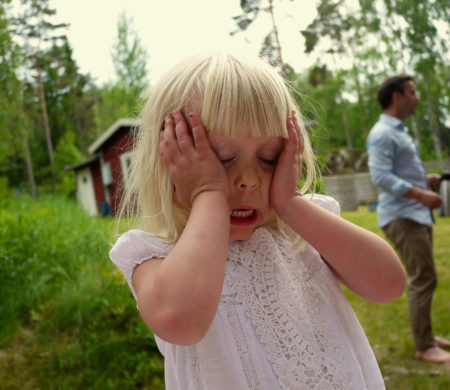 When my daughter recently started her 2-year-old in day care, the phone calls increased to me during that first week—“She’s so upset, crying and clinging to me the minute we enter the parking lot. I hate leaving her!” Of course, my own memories of waiting outside the day care front door listening to her and her brother cry when I first left them resurfaced immediately, although that was many years ago. “Mama Guilt” always seems to stick with us! However, it also helps us to guide and reassure the next generation that some separation anxiety is part of normal childhood development.
When my daughter recently started her 2-year-old in day care, the phone calls increased to me during that first week—“She’s so upset, crying and clinging to me the minute we enter the parking lot. I hate leaving her!” Of course, my own memories of waiting outside the day care front door listening to her and her brother cry when I first left them resurfaced immediately, although that was many years ago. “Mama Guilt” always seems to stick with us! However, it also helps us to guide and reassure the next generation that some separation anxiety is part of normal childhood development.
Our little ones know who cares for them, feeds them, calms their fears, and gives them love and comfort. We nurture this response from the moment they are born or when we bring them home to their forever families. Our children grow to trust us, feel secure with us, and depend solely on us. Is it no wonder that they become upset and scared when left alone with a new caregiver?
It’s always important for parents to be mindful of how separation affects their child, both emotionally and behaviorally. Children ages 9-12 months old can often become hysterical if their primary caregiver leaves. Fear of separation is extremely common in all children less than 5 years old. In the general population, 4-7% of children at any given time are affected by Separation Anxiety. Children who have experienced orphanage care or foster care can have attachment anxieties even during older ages due to their earlier adverse childhood experiences. In general, adopted children can have a heightened level of separation anxiety.
Through their clinginess, tantruming, restlessness, fearful responses, and refusing the attention of another adult, anxious children are expressing their desires to be close to their primary caretaker. With age and a developed sense of security, these behaviors will usually decrease but be prepared for “triggers” to occur which can set the separation cycle off and running again! This regression can be due to stress, illness, changes to their routine, or recurring memories of a difficult separation from their past. Additionally, there is no “magic” age when separation anxiety ends. All children are unique; there is no set timeframe for it to disappear. So, be open to recognizing your child’s signs of feeling “loss” and “trauma” at any point in their development. Don’t punish his feelings or ignore him.
Always remember to interact with your child at his developmental age, not his chronological age. Focus on instilling a sense of safety, security and permanence with him. Here are some tips for helping your child with separation anxiety.
- Create secure situations for little ones when you are at home. For those children who are still small, enable ways for you to go about your daily home routines normally while at the same time including your child and keeping him close. While cooking, let him be near you in a high chair so conversation can continue. If you are going from room to room, consider using a backpack carrier. If working on something that requires your physical attention, let him be in a Pak-n-Play and make eye contact and converse with him while he plays independently.
- Prepare your child for separations. Reinforce the connection you have with each other. Talk about where and when you are leaving, when you will return, and who will be there with him to care for him while you are gone. Reassure him that it will be OK and you understand his feelings. “I know you don’t want Mama to go, but she needs to go to the store. Mama won’t be gone long. Mama always comes back, doesn’t she? Yes, she does because Mama loves you. Aunt Jane will stay with you while I go to the store. You have fun with Aunt Jane, don’t you? You like to play outside and read books with Aunt Jane. Then Mama will be home and we can play together.” This shows consistency and that you trust another adult to temporarily care for them.
- Practice being apart. Start with short periods of time and gradually move to longer ones.
- Develop a good-bye ritual with your child. This also builds trust and consistency. It creates some order for your departure and predictability for your child. Give him a kiss and hug, perhaps a “high five” hand gesture, and maybe create a special saying to add to his reassurance that you will be back, such as “See you later, alligator.” Keep your good-byes quick; don’t draw them out. You may also want to hand your child a favorite toy when you leave as an extra source of comfort.
- Be confident and strong in your own demeanor. Children are so perceptive! Do not “feed” your child’s anxiety by letting him see your own anxiety about the separation. The parent must be strong and confident in their presentation to their child and match their body language to the words they are speaking. If you are anxious and upset, your child will be anxious and upset too! Remember, your child depends on you for reassurance that everything will be OK.
- Help your child learn to relax. Help them learn to help themselves when they feel anxious or afraid by teaching your child the “tricks” often used by trauma focused therapists: slow, rhythmic breathing; holding a “fidget” toy or one that brings security; sitting in a secure, comfortable spot; listening to calm music; or even using a weighted blanket.
Separation anxiety generally indicates that a healthy attachment bond has developed between you and your child. But, if you notice that your child’s symptoms are excessive (unrelenting worry, vomiting, nightmares, recurring physical complaints, etc.) or if they occur regularly over several months, you may want to have your child evaluated by a licensed mental health professional. Preoccupation with caregiver loss may be diagnosed as clinical Separation Anxiety.
However, a little anxiety or concern over being temporarily separated from you is simply part of normal child development. It is an expression of how important you are to your child and how much he loves you. Reassure your little one of your never-ending love for him, that you will always be his “forever” parent, and that you will be home soon to hug and play with him. In no time, his confidence and feeling of security will make those separations easier and easier for everyone concerned!
Photo Credit: Joopey
